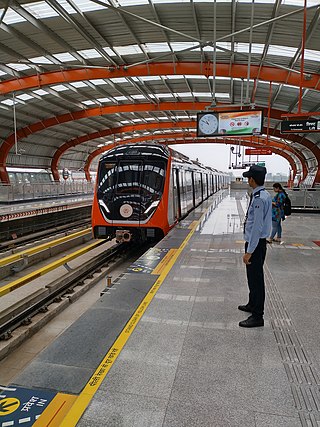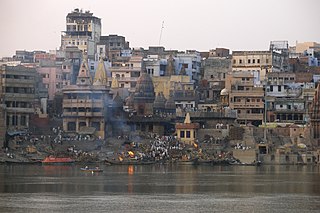
Noida International Airport, also known as Jewar Airport, is an upcoming international airport being constructed near Jewar in Gautam Buddha Nagar District, Uttar Pradesh in India, which will serve the National Capital Region (NCR). The airport is situated in the new planned YEIDA city.

Bengaluru Suburban Railway is an under-construction suburban rail network for the city of Bangalore. A suburban rail system for the city was first proposed in 1983. Since then, several different route proposals were made but no suburban rail project took shape. It was finally approved in the 2019 Railway Budget.

The Lucknow Metro is a mass rapid transit (MRT) system in Lucknow, Uttar Pradesh, India. The metro is owned and operated by the Uttar Pradesh Metro Rail Corporation (UPMRC). The frequency of the metro's services is around 5 - 7 minutes.

The Kanpur Metro is a mass rapid transit (MRT) system in Kanpur, Uttar Pradesh, India. The metro is owned and operated by the Uttar Pradesh Metro Rail Corporation (UPMRC).This is the second smallest Metro system in India by the system length after Agra Metro. This metro system is the fastest constructed metro system in the world, partially opening within 2 years of construction starting in 2019.

Urban rail transit in India plays an important role in intracity transportation in the major cities which are highly populated. It consists of rapid transit, suburban rail, monorail, and tram systems.

The Bhoj Metro is an under construction rapid transit system intended to serve the city of Bhopal, India, the capital of the Indian state of Madhya Pradesh. The total system consists of 6 corridors covering a distance of 104.87 kilometres (65.16 mi). The first phase of the Bhopal Metro project consists of 28 km (17.40 mi) of line 2 & 5 being under construction. This project will cost ₹80 billion (US$1.0 billion) approximately. There will be three types of run – on road, on bridges, and underground in some locations.

The Indore Metro is a rapid transit system which is under construction for the city of Indore, in the state of Madhya Pradesh, India. The total system consists of 11 corridors (lines) covering a distance of 124 kilometres (77 mi). This project will cost approximately ₹12,000 crore (US$1.5 billion). The cost per km will be 182 crores and total cost is 15,000 crores. The metro system will be elevated, underground and on ground. The Indore Metro project has been subject to serious contestation due to the inappropriate shifting of Seismic zone-II to Seismic zone-IV category which has led to increase in budgetary cost for the entire project.

Ayodhya Junction railway station, officially named as Ayodhya Dham Junction railway station, is a railway station in the city of Ayodhya in the state of Uttar Pradesh, India. It is located at Dharmakata, 1.5 km (0.93 mi) south-west from the city centre and 1.2 km (0.75 mi) south-east from Ram Mandir. It is one of two railway junction stations in the city; the other one is Faizabad Junction. The station falls under the Northern Railway zone of the Indian Railways. The station's code is "AY".

Varanasi is a city on the Ganges river in northern India that has a central place in the traditions of pilgrimage, death, and mourning in the Hindu world. The city has a syncretic tradition of Islamic artisanship that underpins its religious tourism. Located in the middle-Ganges valley in the southeastern part of the state of Uttar Pradesh, Varanasi lies on the left bank of the river. It is 692 kilometres (430 mi) to the southeast of India's capital New Delhi and 320 kilometres (200 mi) to the southeast of the state capital, Lucknow. It lies 121 kilometres (75 mi) downstream of Prayagraj, where the confluence with the Yamuna river is another major Hindu pilgrimage site.

The Noida Metro is a rapid transit system connecting the twin cities of Noida and Greater Noida in Gautam Buddh Nagar, Uttar Pradesh, India. The metro network consists of one line, with a total length of 29.7 kilometres (18.5 mi) serving 21 stations. The system has all elevated stations using standard-gauge tracks.

The Uttar Pradesh Metro Rail Corporation(UPMRC) is a joint venture company that operates the Lucknow Metro, Agra Metro and Kanpur Metro.The Varanasi Metro, Prayagraj Metro, Gorakhpur Metro, and Bareilly Metro are proposed by UPMRC. The company's headquarters is at Vipin Khand, Gomti Nagar Lucknow

Agra Metro is a rapid transit network in Agra, the fourth largest city in the Indian state of Uttar Pradesh. The Detailed Project Report (DPR) was submitted in 2014 and cleared by the Uttar Pradesh cabinet in 2015. However, due to the formation of a new government and a new Metro Rail Policy, a revised feasibility report was created with the government finally approving it on the 6 March 2024. The Agra Metro is set to consist of two metro lines, with a total length of 29.65 kilometres (18.42 mi).
The Meerut Metro is an under-construction rapid transit system, which will serve the city of Meerut, Uttar Pradesh, India. It is being built in two phases, out of which the first phase with the first line will cover 23.6 km (14.7 mi) with 13 stations, from Modipuram to Meerut South. It will have nine elevated, three underground stations, one at-grade station as the depot station at Modipuram, and four stations integrated with the Delhi–Meerut RRTS on a single corridor, making the metro the first such rapid transit system in India to be merged directly with a regional railway system. The second phase will include a second line covering 15 km (9.3 mi) from Shradhapuri Phase-II to Jagrati Vihar, with 12 stations, out of which seven will elevated and five will be underground, thereby taking the overall length to 38.6 km (24.0 mi). The metro will also be the fastest metro of India, at an operational speed of 120 km/h (75 mph).

The Varanasi Metro is a light rail transit system proposed for the city of Varanasi, Uttar Pradesh, India. The proposed system consists of 2 corridors that span from BHEL to Banaras Hindu University (19.35 km) and Benia Bagh to Sarnath (9.885 km). The feasibility study of the project was done by RITES and was completed in June 2015.

The Delhi–Meerut Regional Rapid Transit System, also known as Delhi–Meerut RRTS, Delhi–Ghaziabad–Meerut RRTS and coloquially Rapid Rail, is an under-construction and partially operational 82.15 km (51.05 mi)-long semi high-speed rail and regional transit corridor that will connect the National Capital Region (NCR) cities of Delhi, Ghaziabad and Meerut. It is the first of the four rapid rail corridors planned under the first phase of the RapidX project managed by the National Capital Region Transport Corporation (NCRTC). Designed to allow a maximum speed of 180 km/h (110 mph), the distance between Delhi and Meerut will be covered in less than 60 minutes. The project is being executed at a cost of ₹30,274 crore (US$3.8 billion). It will start from Jangpura as the starting station, run through Sarai Kale Khan, the terminal for the three planned corridors, both in Delhi, and end in Modipuram in Meerut. It will have 16 stations and two depots at Duhai and Modipuram.

The Gorakhpur Metrolite is a light rapid transit system proposed for the city of Gorakhpur, Uttar Pradesh, India. The network will consist of 2 elevated lines serving 27 stations with a total length of 27.41 kilometres. The project is estimated to cost ₹4,672 crore (US$590 million). It is expected to be completed by 2024.
Metrolite is a light rail (LRT) urban transit system being planned in India for cities with lower ridership projection and as a feeder system for the existing metro systems. It will cater to lower passenger capacity at a reduced cost than a metro line. It will have dedicated tracks, separated from the road.

The ropeway in India is a public transportation system where cabins, gondolas or open chairs are hauled above the ground with the help of cables. India's Parvatmala Scheme, the world's largest ropeway project, envisages spending ₹1,250 billion (US$16 billion) in public–private partnership (PPP) mode over five years till 2030 to build 200 new ropeway projects of more than 1200 km length, which will decongest the traffic in narrow roads of big cities and provide cheaper connectivity in mountainous and touristy areas. Since 30% of India is covered by mountains, the ropeways are specially useful in mountainous areas, where it is difficult to build roads or railway, as lower cost and higher Return on investment (ROI) projects. Rajgir Ropeway in Bihar, 333m-long chairlift ropeway built in 1960s, is India's first ropeway. As of 2024, the 4km-long Auli Ropeway in Uttarakhand is India's longest and world's the second-longest ropeway behind Vietnam's 7,899.9 m long Hòn Thơm cable car, and when completed the under-construction 5.5km-long Mussoorie-Dehradun Ropeway will be the longest in India. Kashi ropeway is India's first urban ropeway, and world's third urban public transport ropeway behind Bolivia's Mi Teleférico opened in 2014 and Mexico City's Mexicable opened in 2021. This article also contains a list of "glass bridges in India", which are mostly glass bridge skywalk.
Varanasi–Kolkata Expressway, also known as Varanasi–Ranchi–Kolkata Expressway, and NH-319B, is an approved 610 km (380 mi) long, six-lane, greenfield access-controlled expressway, which will connect the spiritual city of Varanasi in Uttar Pradesh with the capital of West Bengal, Kolkata, through the capital of Jharkhand, Ranchi. It will run almost parallel to the Grand Trunk Road or the Asian Highway 1, and will pass through four states–Uttar Pradesh, Bihar, Jharkhand and West Bengal. The expressway is a part of Bharatmala Pariyojana, and it will reduce both travel time and distance, from 12-14 hours to only 6-7 hours, and from 690 km (430 mi) to 610 km (380 mi). It will start from Chandauli district in Uttar Pradesh, and will terminate near Uluberia, Howrah district, West Bengal.














